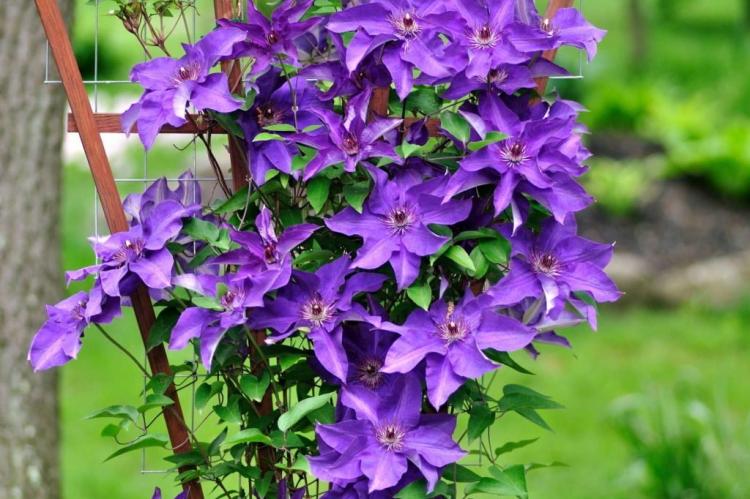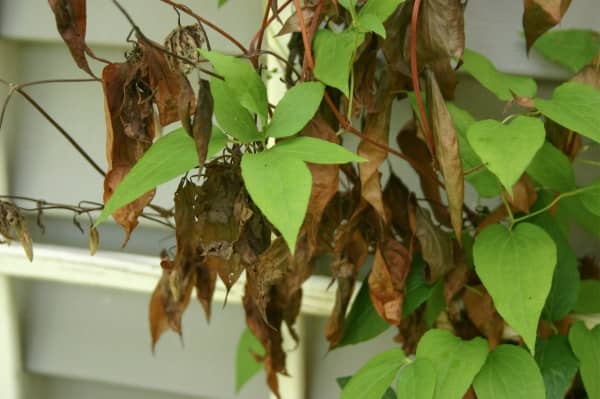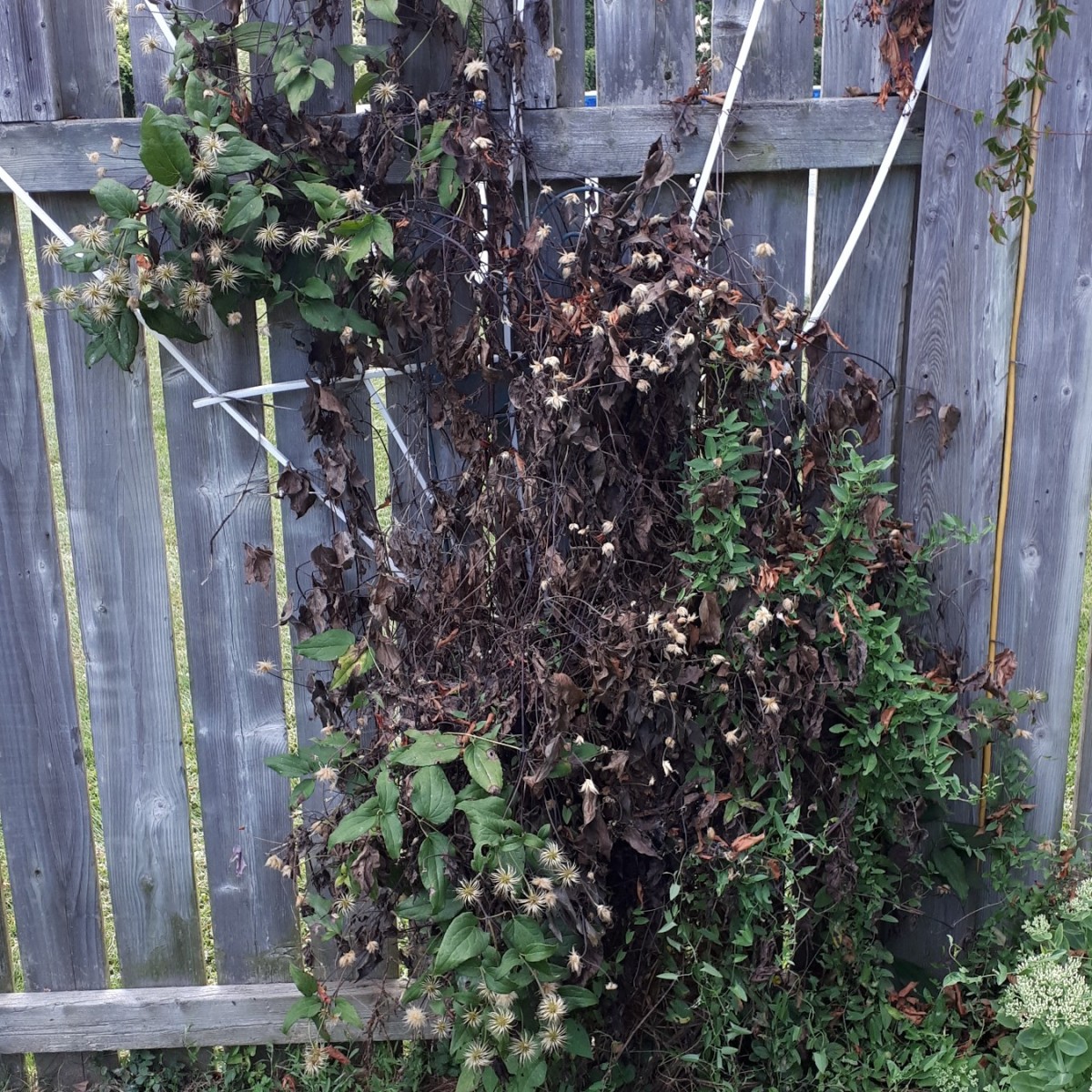Understanding the Life Cycle of Clematis: A Key to Identifying Problems
Clematis is a flowering plant that goes through a series of growth stages, each with its unique characteristics and potential issues. To address the question of “why is my clematis dying,” it’s essential to understand the life cycle of this plant. Clematis typically grows in three stages: the dormant season, the growth season, and the flowering season.
During the dormant season, which usually occurs in winter, the plant’s growth slows down, and it may appear dead. However, this is a natural part of the life cycle, and the plant is simply conserving energy. In the growth season, which typically starts in early spring, the plant begins to produce new shoots and leaves. This is a critical stage, as the plant is vulnerable to pests and diseases.
The flowering season, which usually occurs in late spring and early summer, is the most spectacular stage of the life cycle. Clematis produces showy flowers in a variety of colors, but this stage can also be challenging, as the plant may be susceptible to environmental stressors such as extreme weather conditions and temperature fluctuations.
By understanding the life cycle of clematis, gardeners can identify potential problems and take proactive measures to prevent them. For example, during the growth season, gardeners can inspect the plant regularly for signs of pests or diseases and take action promptly to prevent the issue from spreading. Similarly, during the flowering season, gardeners can provide support for the plant to prevent damage from wind or rain.
In addition to understanding the life cycle, gardeners should also be aware of the common issues that can affect clematis, such as nutrient deficiencies, watering problems, and environmental stressors. By recognizing these potential problems, gardeners can take steps to prevent them and ensure their clematis remains healthy and thriving.
Some common signs of problems in clematis include yellowing leaves, droopy stems, and a lack of flowers. If you notice any of these symptoms, it’s essential to investigate the cause and take action promptly to prevent the issue from spreading. By understanding the life cycle of clematis and being aware of potential problems, gardeners can enjoy a healthy and thriving plant that provides beautiful flowers for years to come.
How to Diagnose Common Clematis Pests and Diseases
Clematis is a popular flowering plant that can be susceptible to various pests and diseases. If you’re wondering “why is my clematis dying,” it’s essential to diagnose the problem correctly to provide effective treatment. In this section, we’ll discuss the most common pests and diseases that can affect clematis, including signs and symptoms to look out for.
One of the most common pests that can affect clematis is the clematis wilt, also known as Phoma clematidina. This fungal disease causes the stems to wilt and turn brown, often accompanied by a white, cottony growth on the affected areas. To diagnose clematis wilt, look for signs of wilting, yellowing, or browning of the leaves and stems.
Another common pest that can affect clematis is the spider mite. These tiny, spider-like insects feed on the sap of the plant, causing yellowing or bronzing of the leaves. To diagnose spider mites, look for fine webbing on the leaves and stems, as well as tiny, moving dots on the underside of the leaves.
Other common pests and diseases that can affect clematis include aphids, whiteflies, and powdery mildew. Aphids are small, soft-bodied insects that feed on the sap of the plant, causing curled or distorted leaves. Whiteflies are tiny, winged insects that feed on the sap of the plant, causing yellowing or stunted growth. Powdery mildew is a fungal disease that causes a white, powdery growth on the leaves and stems.
To diagnose these pests and diseases, it’s essential to inspect your clematis plant regularly, looking for signs of infestation or infection. Check the leaves, stems, and flowers for any unusual growths, discoloration, or damage. If you suspect a pest or disease problem, take action promptly to prevent the issue from spreading.
Treatment options for clematis pests and diseases vary depending on the specific problem. For fungal diseases like clematis wilt and powdery mildew, treatment may involve applying a fungicide or removing infected areas of the plant. For insect pests like aphids and spider mites, treatment may involve applying an insecticide or introducing natural predators like ladybugs or lacewings.
Prevention is also key to maintaining a healthy clematis plant. Regularly inspect your plant for signs of pests or diseases, and take action promptly if you suspect a problem. Keep your plant in a well-ventilated area, and avoid overwatering or underwatering, which can exacerbate pest and disease problems.
Nutrient Deficiencies and Soil Quality: The Hidden Culprits Behind Clematis Decline
Clematis is a flowering plant that requires a balanced diet of nutrients to thrive. However, nutrient deficiencies can be a common cause of decline in clematis plants. If you’re wondering “why is my clematis dying,” it’s essential to consider the role of nutrient deficiencies in the plant’s health.
One of the most common nutrient deficiencies that can affect clematis is nitrogen deficiency. Nitrogen is essential for leaf growth and development, and a lack of nitrogen can cause yellowing or stunted leaves. To diagnose nitrogen deficiency, look for signs of yellowing or pale leaves, especially in the lower parts of the plant.
Another common nutrient deficiency that can affect clematis is phosphorus deficiency. Phosphorus is essential for root development and flower production, and a lack of phosphorus can cause stunted growth or reduced flowering. To diagnose phosphorus deficiency, look for signs of stunted growth or reduced flowering, especially in the upper parts of the plant.
Potassium deficiency is also a common issue in clematis plants. Potassium is essential for overall plant health and resistance to disease, and a lack of potassium can cause weak or brittle stems. To diagnose potassium deficiency, look for signs of weak or brittle stems, especially in the lower parts of the plant.
In addition to nutrient deficiencies, soil quality can also play a significant role in clematis health. Clematis prefers well-draining, fertile soil that is rich in organic matter. Poor soil quality can cause a range of problems, including nutrient deficiencies, waterlogging, and root rot.
To improve soil fertility and address nutrient deficiencies, consider adding organic matter such as compost or manure to the soil. You can also use fertilizers specifically formulated for clematis, which typically contain a balanced mix of nitrogen, phosphorus, and potassium.
It’s also essential to consider the pH level of the soil, as clematis prefers a slightly acidic to neutral soil pH (around 6.0-7.0). If the soil pH is too high or too low, it can cause nutrient deficiencies and other problems.
By addressing nutrient deficiencies and improving soil quality, you can help promote healthy growth and prevent decline in your clematis plant. Regularly monitoring the plant’s condition and taking action promptly to address any issues can also help prevent problems from arising in the first place.
Watering Woes: How Over- and Under-Watering Can Kill Your Clematis
Watering is a crucial aspect of clematis care, and both over- and under-watering can be detrimental to the plant’s health. If you’re wondering “why is my clematis dying,” it’s essential to consider the role of watering in the plant’s decline.
Over-watering is a common mistake that can lead to root rot, a condition that can be fatal to clematis. When the soil is consistently waterlogged, the roots can’t breathe, and the plant becomes vulnerable to disease. To avoid over-watering, make sure to check the soil moisture regularly, and only water when the top inch of soil feels dry to the touch.
Under-watering, on the other hand, can cause the plant to become stressed, leading to a range of problems, including leaf drop, reduced flowering, and increased susceptibility to pests and diseases. To avoid under-watering, make sure to water your clematis regularly, especially during hot and dry weather.
The optimal watering schedule for your clematis will depend on a range of factors, including climate, soil type, and time of year. In general, clematis prefers moist, well-draining soil, but can tolerate some drought. However, it’s essential to avoid extreme fluctuations in soil moisture, as this can cause stress to the plant.
To determine the optimal watering schedule for your clematis, consider the following factors:
Climate: Clematis prefers a cool, moist climate, but can tolerate some heat and dryness. In hot and dry climates, it’s essential to water more frequently to prevent drought stress.
Soil type: Clematis prefers well-draining soil that is rich in organic matter. In heavy clay soils, it’s essential to water more carefully to avoid waterlogging.
Time of year: Clematis has different watering needs at different times of the year. During the growing season, it’s essential to water more frequently to promote healthy growth. During the dormant season, it’s essential to reduce watering to prevent root rot.
By understanding the optimal watering schedule for your clematis, you can help promote healthy growth and prevent decline. Regularly monitoring the plant’s condition and adjusting the watering schedule as needed can also help prevent problems from arising in the first place.
Pruning and Training: The Key to Promoting Healthy Growth and Preventing Decline
Pruning and training are essential techniques for promoting healthy growth and preventing decline in clematis. By pruning and training your clematis correctly, you can encourage the plant to produce more flowers, improve its overall shape and size, and prevent problems such as tangling and disease.
Pruning is a critical aspect of clematis care, as it helps to control the plant’s size and shape, promotes healthy growth, and encourages flowering. There are several types of pruning that can be used on clematis, including deadheading, cutting back, and thinning out.
Deadheading is the process of removing spent flowers from the plant, which helps to encourage more blooms and improve the plant’s overall appearance. Cutting back involves reducing the length of the stems to control the plant’s size and shape, while thinning out involves removing select stems to improve air circulation and promote healthy growth.
Training is also an important aspect of clematis care, as it helps to support the plant’s growth and promote healthy development. Clematis can be trained to climb up trellises, arbors, or other supports, which helps to keep the plant upright and promote better flowering.
To train your clematis, start by selecting a suitable support, such as a trellis or arbor. Then, gently twine the stems around the support, making sure to leave enough space for the plant to grow and develop. As the plant grows, continue to train the stems, gently twining them around the support to promote healthy growth and flowering.
By pruning and training your clematis correctly, you can help to promote healthy growth and prevent decline. Regular pruning and training can also help to prevent problems such as tangling and disease, which can be detrimental to the plant’s health.
If you’re wondering “why is my clematis dying,” it’s possible that pruning and training may be the solution. By pruning and training your clematis correctly, you can help to promote healthy growth and prevent decline, ensuring that your plant remains healthy and thriving for years to come.
Environmental Factors: How Weather, Sun, and Temperature Can Impact Clematis Health
Environmental factors such as weather, sun, and temperature can have a significant impact on clematis health. If you’re wondering “why is my clematis dying,” it’s essential to consider the role of environmental factors in the plant’s decline.
Extreme weather conditions, such as heavy rain, strong winds, and intense sunlight, can cause damage to clematis plants. Heavy rain can cause waterlogged soil, which can lead to root rot and other problems. Strong winds can cause damage to the plant’s stems and leaves, while intense sunlight can cause scorching and discoloration.
Sun exposure is also an essential factor to consider when growing clematis. While clematis plants require some sunlight to photosynthesize and produce flowers, too much sun can cause damage. In general, clematis plants prefer partial shade to full sun, depending on the variety.
Temperature fluctuations can also impact clematis health. Clematis plants prefer temperatures between 65°F and 75°F (18°C and 24°C) during the day and around 55°F (13°C) at night. Avoid placing clematis plants in areas with extreme temperature fluctuations, such as near heating vents or drafty windows.
To protect your clematis from environmental factors, consider providing some protection from the elements. For example, you can use a trellis or arbor to provide shade and support for the plant. You can also use mulch or other ground covers to retain moisture and regulate soil temperature.
Regular monitoring of your clematis plant’s condition can also help you identify potential problems caused by environmental factors. Check your plant regularly for signs of damage, disease, or pests, and take action promptly to address any issues.
By understanding the impact of environmental factors on clematis health, you can take steps to protect your plant and promote healthy growth. Regular monitoring and proper care can help prevent problems caused by weather, sun, and temperature fluctuations, ensuring that your clematis remains healthy and thriving.
How to Revive a Dying Clematis: A Step-by-Step Guide
If you’re wondering “why is my clematis dying,” it’s essential to take action promptly to revive the plant. Reviving a dying clematis requires a combination of proper care, nutrition, and pruning. In this section, we’ll provide a step-by-step guide on how to revive a dying clematis.
Step 1: Assess the Plant’s Condition
Before you start reviving your clematis, it’s essential to assess the plant’s condition. Check for signs of disease, pests, or nutrient deficiencies. Look for yellowing or browning leaves, black spots, or white powdery patches. Check the stems for signs of damage or breakage.
Step 2: Prune the Plant
Pruning is an essential step in reviving a dying clematis. Remove any dead or damaged stems, and cut back the plant to about 6-8 inches from the ground. This will help the plant focus its energy on producing new growth rather than trying to sustain old, damaged stems.
Step 3: Provide Optimal Care and Nutrition
Once you’ve pruned the plant, it’s essential to provide optimal care and nutrition. Make sure the soil is well-draining and rich in organic matter. Water the plant regularly, but avoid overwatering. Fertilize the plant with a balanced fertilizer, and provide support for the stems as they grow.
Step 4: Monitor the Plant’s Progress
After you’ve revived your clematis, it’s essential to monitor the plant’s progress regularly. Check for signs of new growth, and adjust your care and nutrition routine as needed. Keep an eye out for pests and diseases, and take action promptly if you notice any problems.
By following these steps, you can revive a dying clematis and help it thrive. Remember to be patient, as reviving a dying plant takes time and effort. With proper care and nutrition, your clematis should be back to its former glory in no time.
Preventing Future Problems: Tips for Maintaining a Healthy and Thriving Clematis
By following the tips and guidelines outlined in this article, you can help prevent future problems and maintain a healthy and thriving clematis. Regular monitoring, proper care, and preventative measures are key to keeping your clematis plant happy and healthy.
Regular Monitoring
Regular monitoring is essential to catch any potential problems before they become major issues. Check your clematis plant regularly for signs of pests, diseases, or nutrient deficiencies. Look for yellowing or browning leaves, black spots, or white powdery patches. Check the stems for signs of damage or breakage.
Proper Care
Proper care is essential to maintaining a healthy and thriving clematis. Make sure to provide your clematis with the right amount of water, nutrients, and support. Avoid overwatering, which can lead to root rot and other problems. Fertilize your clematis regularly, but avoid overfertilizing, which can cause more harm than good.
Preventative Measures
Preventative measures can help prevent future problems and maintain a healthy and thriving clematis. Consider using organic or chemical control methods to prevent pests and diseases. Use physical barriers or row covers to prevent pests from reaching your clematis. Consider using mulch or other ground covers to retain moisture and regulate soil temperature.
By following these tips and guidelines, you can help prevent future problems and maintain a healthy and thriving clematis. Remember to be patient, as maintaining a healthy clematis takes time and effort. With proper care and attention, your clematis should thrive for years to come.
If you’re still wondering “why is my clematis dying,” consider consulting with a gardening expert or taking a closer look at your plant’s specific needs. By providing your clematis with the right care and attention, you can help it thrive and enjoy its beautiful blooms for years to come.








